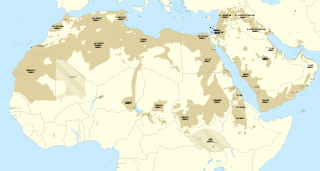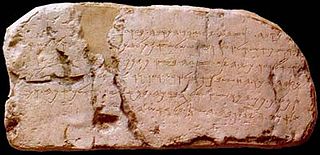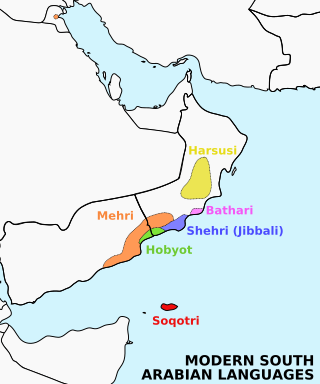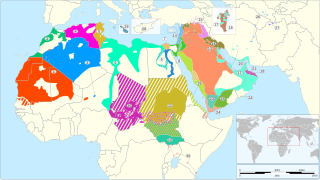
The Semitic languages are a branch of the Afroasiatic language family. They include Arabic, Amharic, Tigrinya, Aramaic, Hebrew, Maltese and numerous other ancient and modern languages. They are spoken by more than 330 million people across much of West Asia, North Africa, the Horn of Africa, Malta, and in large immigrant and expatriate communities in North America, Europe, and Australasia. The terminology was first used in the 1780s by members of the Göttingen school of history, who derived the name from Shem, one of the three sons of Noah in the Book of Genesis.

Yemeni Arabic is a cluster of varieties of Arabic spoken in Yemen and southwestern Saudi Arabia. It is generally considered a very conservative dialect cluster, having many classical features not found across most of the Arabic-speaking world.

Biblical Hebrew, also called Classical Hebrew, is an archaic form of the Hebrew language, a language in the Canaanitic branch of the Semitic languages spoken by the Israelites in the area known as the Land of Israel, roughly west of the Jordan River and east of the Mediterranean Sea. The term ʿiḇrîṯ "Hebrew" was not used for the language in the Hebrew Bible, which was referred to as שְֹפַת כְּנַעַןśəp̄aṯ kənaʿan "language of Canaan" or יְהוּדִיתYəhûḏîṯ, "Judean", but it was used in Koine Greek and Mishnaic Hebrew texts.

Gulf Arabic or Khaleeji is a variety of the Arabic language spoken in Eastern Arabia around the coasts of the Persian Gulf in Kuwait, Bahrain, Qatar, the United Arab Emirates, southern Iraq, eastern Saudi Arabia, northern Oman, and by some Iranian Arabs.

Kumzari is a Southwestern Iranian language that is similar to the Persian, Achomi and Luri languages. Although vulnerable, it survives today with between 4,000 and 5,000 speakers. It is spoken by Kumzaris on the Kumzar coast of Musandam Peninsula as well as the Shihuh in the United Arab Emirates. Kumzari speakers can also be found in the towns of Dibba and Khasab as well as various villages, and on Larak Island.

Sabaic, sometimes referred to as Sabaean, was an Old South Arabian language that was spoken between c. 1000 BC and the 6th century AD by the Sabaeans. It was used as a written language by some other peoples of the ancient civilization of South Arabia, including the Ḥimyarites, Ḥashidites, Ṣirwāḥites, Humlanites, Ghaymānites, and Radmānites. Sabaic belongs to the South Arabian Semitic branch of the Afroasiatic language family. Sabaic is distinguished from the other members of the Old South Arabian group by its use of h to mark the third person and as a causative prefix; all of the other languages use s1 in those cases. Therefore, Sabaic is called an h-language and the others s-languages. Numerous other Sabaic inscriptions have also been found dating back to the Sabean colonization of Africa.
Qoph is the nineteenth letter of the Semitic abjads, including Arabic qāfق, Aramaic qop 𐡒, Hebrew qūp̄ק, Phoenician qōp 𐤒, and Syriac qōp̄ ܩ.
Proto-Semitic is the reconstructed proto-language common ancestor to the Semitic language family. There is no consensus regarding the location of the Proto-Semitic Urheimat: scholars hypothesize that it may have originated in the Levant, the Sahara, the Horn of Africa, the Arabian Peninsula, or northern Africa.

Lebanese Arabic, or simply Lebanese, is a group of accents or a variety of Levantine Arabic, indigenous to and primarily spoken in Lebanon, with some linguistic influences borrowed from other Middle Eastern and European languages.

Mehri is the most spoken of the Modern South Arabian languages (MSALs), a subgroup of the Semitic branch of the Afroasiatic family. It is spoken by the Mehri tribes, who inhabit isolated areas of the eastern part of Yemen, western Oman, particularly the Al Mahrah Governorate, with a small number in Saudi Arabia near the Yemeni and Omani borders. Up to the 19th century, speakers lived as far north as the central part of Oman.

Hadhrami Arabic, or Ḥaḍrami Arabic (ḤA), is a variety of Arabic spoken by the Hadharem (Ḥaḍārem) living in the region of Hadhramaut in southeastern Yemen, with a small number of speakers found in Kenya.
Northwest Arabian Arabic is a proposed subfamily of Arabic encompassing the traditional Bedouin dialects of the Sinai Peninsula, the Negev, Gaza Strip, southern Jordan, and the northwestern corner of Saudi Arabia.

Shihhi Arabic is a variety of Arabic primarily spoken in the Musandam Governorate of Oman and Ras al Khaimah emirate of UAE. It has been suggested that Shihhi Arabic has two main dialect groups, known as "inland" and "coastal". The Al Shehhi, Al Hebsi, Al Dhuhoori and Al Shemaili tribes speak it.

Shehri, also known as Jibbali, is a Modern South Arabian language; it and the three island varieties of Soqoṭri comprise the eastern branch of Modern South Arabian. It is spoken by a small native population inhabiting the coastal towns and the mountains and wilderness areas upland from Salalah, located in the Dhofar Governorate in southwestern Oman. The autonym for speakers is əḥklí, plural əḥkló.

Varieties of Arabic are the linguistic systems that Arabic speakers speak natively. Arabic is a Semitic language within the Afroasiatic family that originated in the Arabian Peninsula. There are considerable variations from region to region, with degrees of mutual intelligibility that are often related to geographical distance and some that are mutually unintelligible. Many aspects of the variability attested to in these modern variants can be found in the ancient Arabic dialects in the peninsula. Likewise, many of the features that characterize the various modern variants can be attributed to the original settler dialects as well as local native languages and dialects. Some organizations, such as SIL International, consider these approximately 30 different varieties to be separate languages, while others, such as the Library of Congress, consider them all to be dialects of Arabic.

Peninsular Arabic are the varieties of Arabic spoken throughout the Arabian Peninsula. This includes the countries of Saudi Arabia, Yemen, Oman, United Arab Emirates, Kuwait, Bahrain, Qatar, Southern Iran, Southern Iraq and Jordan.
Syrian Arabic refers to any of the Arabic varieties spoken in Syria, or specifically to Levantine Arabic.
Palatalization is a historical-linguistic sound change that results in a palatalized articulation of a consonant or, in certain cases, a front vowel. Palatalization involves change in the place or manner of articulation of consonants, or the fronting or raising of vowels. In some cases, palatalization involves assimilation or lenition.
This article is about the phonology of Levantine Arabic also known as Shāmi Arabic, and its sub-dialects.
The phonological system of the Hejazi Arabic consists of approximately 26 to 28 native consonant phonemes and 8 vowel phonemes:. Consonant length and vowel length are both distinctive in Hejazi.












